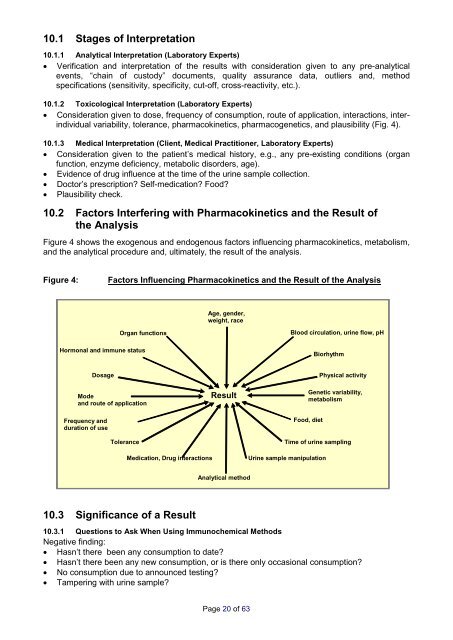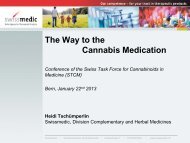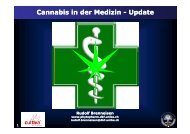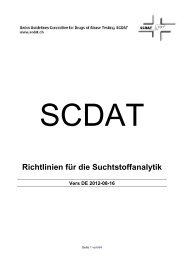Guidelines for Drugs of Abuse Testing vers 2012 - Brenneisen
Guidelines for Drugs of Abuse Testing vers 2012 - Brenneisen
Guidelines for Drugs of Abuse Testing vers 2012 - Brenneisen
You also want an ePaper? Increase the reach of your titles
YUMPU automatically turns print PDFs into web optimized ePapers that Google loves.
10.1 Stages <strong>of</strong> Interpretation<br />
10.1.1 Analytical Interpretation (Laboratory Experts)<br />
• Verification and interpretation <strong>of</strong> the results with consideration given to any pre-analytical<br />
events, “chain <strong>of</strong> custody” documents, quality assurance data, outliers and, method<br />
specifications (sensitivity, specificity, cut-<strong>of</strong>f, cross-reactivity, etc.).<br />
10.1.2 Toxicological Interpretation (Laboratory Experts)<br />
• Consideration given to dose, frequency <strong>of</strong> consumption, route <strong>of</strong> application, interactions, interindividual<br />
variability, tolerance, pharmacokinetics, pharmacogenetics, and plausibility (Fig. 4).<br />
10.1.3 Medical Interpretation (Client, Medical Practitioner, Laboratory Experts)<br />
• Consideration given to the patient’s medical history, e.g., any pre-existing conditions (organ<br />
function, enzyme deficiency, metabolic disorders, age).<br />
• Evidence <strong>of</strong> drug influence at the time <strong>of</strong> the urine sample collection.<br />
• Doctor’s prescription? Self-medication? Food?<br />
• Plausibility check.<br />
10.2 Factors Interfering with Pharmacokinetics and the Result <strong>of</strong><br />
the Analysis<br />
Figure 4 shows the exogenous and endogenous factors influencing pharmacokinetics, metabolism,<br />
and the analytical procedure and, ultimately, the result <strong>of</strong> the analysis.<br />
Figure 4: Factors Influencing Pharmacokinetics and the Result <strong>of</strong> the Analysis<br />
Dosage<br />
Frequency and<br />
duration <strong>of</strong> use<br />
Organ functions<br />
Hormonal and immune status<br />
Mode<br />
and route <strong>of</strong> application<br />
Tolerance<br />
Medication, Drug interactions<br />
10.3 Significance <strong>of</strong> a Result<br />
Age, gender,<br />
weight, race<br />
Result<br />
Analytical method<br />
10.3.1 Questions to Ask When Using Immunochemical Methods<br />
Negative finding:<br />
• Hasn’t there been any consumption to date?<br />
• Hasn’t there been any new consumption, or is there only occasional consumption?<br />
• No consumption due to announced testing?<br />
• Tampering with urine sample?<br />
Page 20 <strong>of</strong> 63<br />
Blood circulation, urine flow, pH<br />
Biorhythm<br />
Physical activity<br />
Genetic variability,<br />
metabolism<br />
Food, diet<br />
Time <strong>of</strong> urine sampling<br />
Urine sample manipulation






